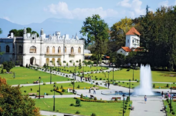The Golden Fleece - Ilse Hönig
Sponsor Event for the Sugdidi Team Festival in Georgia
The Mystery of the Golden Fleece and Its Future-orientated Impulses for Therapeutic Practice
Interview with Ilse Hönig on December 13, 2024 at 19:00 CET
Are you familiar with the tale of the Argonauts? What do you know about the theft of the Golden Fleece from Colchis and the trials that had to be faced? What do you make of the miracles that occurred and the many terrible things that happened?
But what is it really about? What are its mystical backgrounds that echo through the legends of Christian Rosenkreuz and the medieval Order of the Golden Fleece?
Ilse Hönig has been part of Eurythmy4you from the very beginning. She will explore these questions together with Theodor, and you are warmly invited to think and feel along with them. If you can’t attend live, you will receive the replay.
For Your Preparation
Background Knowledge on the Golden Fleece and the Mysteries of Colchis
1. Mythological Background
Colchis and the Golden Fleece
Colchis, the land of the legendary Golden Fleece in Greek mythology, is located in present-day western Georgia along the eastern coast of the Black Sea. Historic cities of Colchis include Sugdidi, Kutaisi, and Batumi.
As early as the 13th century BCE, Colchis was mentioned in Hittite and Assyrian sources. In the 8th to 6th centuries BCE, it was a cultural and economic centre known for its wealth in gold and other natural resources. Archaeological finds from this period, such as elaborate gold works, attest to Colchis's cultural flourishing and its expertise in metallurgy. By the 6th century BCE at the latest, Colchis was regarded as a legendary kingdom of great importance.
In the story of the Argonauts, Colchis is depicted as a mystical realm ruled by King Aeetes. The magical Golden Fleece, a golden ram's skin with supernatural powers, symbolizes and protects the kingdom's power. It is guarded by a terrifying, invincible dragon that never sleeps.
Jason and the Argonauts
Pelias was the tyrannical ruler of Iolcus, a port city 150 km north of Athens. Previously, he had overthrown his half-brother Aeson, the rightful king of Iolcus. Jason, Aeson's son and rightful heir to Iolcus, was hidden away by his mother and raised in secret.
When Jason grew up, he returned to Iolcus to claim his rightful place as king. Pelias, unwilling to relinquish his throne, gave Jason an almost impossible task: to retrieve the Golden Fleece from the distant Colchis to prove his loyalty and capabilities.
Hoping Jason would fail, Pelias underestimated him. Jason gathered a group of brave heroes, the Argonauts, to accompany him on the expedition. The journey to retrieve the Golden Fleece became one of the most famous and adventurous tales in Greek mythology, exploring themes of bravery, betrayal, love, magic, and destiny.
The Journey to Colchis
The Argonauts traveled on the ship *Argo*, equipped with magical powers by Athena. Some of the most notable members included:
- Heracles (Hercules), the strongest hero in Greek mythology
- Orpheus, the renowned musician
- Atalanta, the only woman in the group, known for her speed and hunting skills
- Theseus, the slayer of the Minotaur
- Castor and Pollux, the twin brothers
The Argonauts faced numerous challenges, including the dangerous passage of the Symplegades (Clashing Rocks). Following advice from the blind seer Phineas, they sent a dove ahead, navigating quickly themselves when the rocks parted, escaping as the rocks crashed together behind them.
Their journey also took them to the land of the Amazons, a warrior tribe of women. After a fierce conflict, they continued their adventure, eventually reaching Colchis, the land where the Golden Fleece was kept.
The Trials
Jason has to overcome several difficult tasks set by Aeetes:
- The first task is to capture two oxen and plough a field with them. However, these oxen are of a supernatural nature, as they are not only exceptionally strong, but can also spit flames from their nostrils. Jason gets help from Medea, the king's daughter, who has fallen in love with Jason and supports him with her magical abilities. With the help of her magic potion, Jason manages to tame the oxen, train them and plough the field with them.
- The second task is even more difficult. He must plant the field with dragon teeth, which come from the dragon that guards the Golden Fleece and never sleeps. When they are planted in the ground, they grow into armed warriors who immediately come to life to fight Jason and the Argonauts. Medea advises him not to fight the warriors directly, but to engage them in a battle against each other. When the warriors attack, he throws a stone into their midst, causing them to fight and destroy each other. In this way, Jason fulfils the task without having to defeat them directly.
Both tasks relied on magic and cunning rather than brute force. They test not only Jason's physical strength, but also his ingenuity. Medea's support through her magical powers is crucial to their success, and shows how deep the bond between Jason and Medea is.
Securing the Golden Fleece
After succeeding in these trials, Jason faced the ultimate challenge: the dragon guarding the Golden Fleece. Medea prepared a potion to lull the dragon into a deep sleep, enabling Jason to take the fleece golden fleece from the tree to which it is attached without danger.
The Escape
However, Jason is not safe with the Golden Fleece in his hand. King Aeetes learns of Jason's theft and sends his men to pursue the fugitives. Medea also plays a decisive role here. She helps Jason and the Argonauts by luring her own brother, Apsyrtus, into a trap. In some versions of the legend, it is reported that the Argonauts kill Aeetes' son, in others that Medea cuts her brother into pieces herself and throws the pieces into the sea to stop the pursuers. This enables the Argonauts to escape unhindered with the fleece.
Although the Argonauts successfully returned the Golden Fleece after a journey full of further dangers, deceptions and challenges, the return home brought many unresolved conflicts and tragic events for Jason and the Argonauts.
The End
However, Pelias does not voluntarily hand over his rule to the rightful heir to the throne, Jason, and hopes to be rejuvenated by a magic potion. Through a trick by Medea, his own daughters are killed in the bath. Jason thus becomes the rightful king of Iolkos, but this victory is overshadowed by bitterness and does not lead to a happy ending. The relationship between him and Medea becomes increasingly strained.
Eventually, the couple move to Corinth, where they want to start a new life. But the dramatic turning point comes when Jason falls in love with Glauce, the daughter of Creon, the king of Corinth, and believes that he can strengthen his influence and power through this marriage. He assumes that he can simply free himself from Medea, but she takes cruel revenge. She gives Glauce a beautiful, magically-powered golden dress, which burns her when she puts it on. To rob Jason of the last remnants of his joy and pride, Medea kills her two children in her rage and despair. She leaves Corinth and moves to Athens, where she once again becomes embroiled in political intrigue and conflict.
Jason has lost everything that was once dear to him - his family, his children and his new wife. In many versions of the saga, he dies in loneliness and despair under the wreckage of the Argo, the ship that had helped him to fame and power. However, there are also variations of the saga in which Jason dies as an old, broken man in loneliness and despair - despised by the people who used to admire him.
2. Spiritual Perspectives *
1. Symbolism of the Argonautic Journey in Occult Literature
In esoteric literature, the journey of the Argonauts is often interpreted as an allegory of a spiritual journey or initiation. The Argonauts symbolically represent the souls of initiates, seeking knowledge, enlightenment, or divine truth. Here, geography and places play a symbolic role, connected more to metaphysical concepts than to actual geographical distances.
The myth of the Argonauts is a central story about the journey for the Golden Fleece.The Golden Fleece hung on an oak tree in Colchis and was guarded by a fire-breathing dragon. It symbolizes the astral body of Christ – a healing impulse for all humanity.
Simultaneously, influential figures such as Moses, who brought the Ten Commandments to the East, and Akhenaten, who introduced a cult of light in Egypt, played formative roles. At that time, the Sun was in the constellation of Aries, which points to cosmic rhythms closely tied to the mysteries of that era.
The development of humanity can be divided into cultural epochs, each with a specific spiritual task.
- In the first post-Atlantean cultural epoch there is still a direct connection between humanity and the divine-spiritual world.
- In the second cultural epoch, people lived in a vivid world of images where the divine was directly involved.
- In the third epoch, the sentient soul began to lose its connection to spiritual origins, yet angels continued to guard the primal wisdom. This wisdom is expressed in the Grail and the imagery of wine and bread.
- In the fourth cultural epoch, characterized by the intellectual soul, thoughts became central to perception. With this development, conscience emerged as a new sense organ, allowing people to experience God inwardly. This was accompanied by the task of overcoming the animal aspects of the soul, as hinted at in the Artemis Mysteries.
- In today’s fifth cultural epoch, the epoch of the consciousness soul, the task is to understand the Christ Mysteries in their deepest essence. Figures like Titurel and Parsifal became guardians of the Grail. Gnosticism sought to explore the mystery of Golgotha.
- The mythical figure of Presbyter John is associated with the Colchian Mysteries on the Black Sea and points to the spiritual self of the sixth cultural epoch.
The Black Sea played a special role as a spiritual center in the 8th and 9th centuries. On the eastern coast of the kingdom of Colchis lay the city of Phasis, which hosted a significant academy. The Kolchic Mysteries were led by Buddha.
Asgard, the home of the gods in Nordic mythology, is also associated with the Black Sea region. To the north, the Drott Mysteries were active, linked to Michael and Vidar. To the south, the Logos Mysteries, closely associated with Christ, were cultivated.
The Mars Mysteries influenced the north, the Venus Mysteries the south, while the center, Europe, was shaped by the Jupiter Mysteries.
The science of initiation helps us today to grasp and advance the tasks of the consciousness soul. It provides guidance to connect personal development with spiritual impulses.
The Golden Fleece stands as a symbol for the astral body of Christ, indicating that through spiritual consciousness work, healing and development of all humanity are possible.
* Notes and additions by Ilse Höning on a lecture by
Vladimir Khvitia on June 3, 2024, in Salzburg


